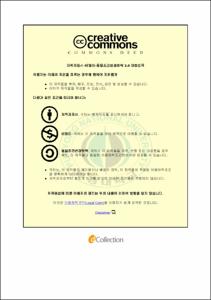경남지역 산업체 급식서비스 만족도와 고객충성도와의 관계
- Alternative Title
- Relationship between satisfaction with foodservice quality and customer loyalty of industry in Gyeongnam
- Abstract
- The purpose of the present study was to select five industrial catering facilities to analyze and grasp the effects of foodservice satisfaction on customer loyalty in order to provide the data necessary for improving industrial contract catering. The survey was conducted from July 20, 2012 to August 31, 2012. Five businesses in the Gyeongnam region that conducted contract catering were selected and questionnaires were received from 300 office workers and production workers. All 300 questionnaires were used for statistical analyses. The data were statistically processed using SPSS WIN 18.0 by conducting frequency analyses, t-test, one-way ANOVA, and Multiple Regression analyses. The results of the present study are as follows:
1. The participants’ reliability coefficients for foodservice satisfaction with their catering service was shown to be 0.97, and the reliability coefficient of customer loyalty assessment tools was shown to be 0.91.
2. The total average of the assessment of satisfaction with the foodservice was shown to be 3.51 points, and foodservice satisfaction with hygiene factors was shown to be the highest. The results of foodservice satisfaction assessment with regard to other areas were as follows: Those in their 40s or more showed the highest total average. Those who had graduated only from high school showed a higher total average than those who had graduated from university or had had even further education. Office workers showed a significantly higher total average than production workers (p<0.001). Production workers showed significantly higher foodservice satisfaction than office workers for menu, service, and environment factors (p<0.001) and also for hygiene factors (p<0.01). Use periods of two years or longer but shorter than four years showed the highest total average.
3. The total average customer loyalty was shown to be 3.46points, and customer loyalty for repurchase intentions was shown to have the highest score. The results of loyalty assessment with regard to specific areas were as follows: Those in their 40s or older showed higher customer loyalty than those in their 20s or 30s. Those who had graduated from university or who had had more education showed a higher total average than those who had graduated from high school or had less education. Production workers showed a significantly higher total average than office workers (p<0.001). Repurchase intentions were shown to be higher among production workers than among office workers, and word-of-mouth intentions were shown to be significantly higher among production workers than among office workers (p<0.01). Intentions not to switch were shown to be significantly higher among production workers than among office workers (p<0.001). Use periods of two years or longer but shorter than four years showed the highest customer loyalty.
4. As for the correlations between factors for foodservice satisfaction with catering service and customer loyalty, menu, service, hygiene, and environmental factors showed significant positive (+)correlations with revisit intensions, word-of-mouth intentions, and intentions not to switch. In particular, revisit intensions (p<0.01) showed significantly higher correlations with menu factors compared other factors and word-of-mouth intentions, and intentions not to switch (p<0.01) showed significantly higher correlations with service factors compared to other factors.
5. The factors for foodservice satisfaction that had the largest effects on repurchase intentions were hygiene and menus, in order of precedence. The factors for foodservice satisfaction that had the largest effects on word of mouth intentions were service, hygiene, and menus, in order of precedence. The factor for foodservice satisfaction that had the largest effects on intentions not to switch was shown to be menus. The factors for foodservice satisfaction that had the largest effects on overall customer loyalty were hygiene, menus, and service in order of precedence.
Through these results, it could be seen that customer loyalty should be managed because foodservice satisfaction in industrial catering was connected to customer loyalty. For customer loyalty for industrial contract catering, continuous research and development in terms of menus, service, and hygiene and the enhancement of using customers’ satisfaction through differentiation from other businesses are important. Since menus have the largest effects on customer loyalty, health-oriented menus in line with trends should be provided, food materials in season should be used, and the development of manuals for benchmarking and surveys of preferred menus is necessary.
- Issued Date
- 2013
- Awarded Date
- 2013. 2
- Type
- Dissertation
- Publisher
- 부경대학교
- Alternative Author(s)
- Kim, Hyeon Ju
- Affiliation
- 부경대학교 교육대학원
- Department
- 교육대학원 영양교육전공
- Advisor
- 류은순
- Table Of Contents
- Ⅰ. 서 론
1. 서 언 1
2. 연구목적을 위한 가설 설정 4
Ⅱ. 이론적 배경
1. 급식서비스 만족도 5
2. 고객충성도 8
3. 고객만족도와 고객충성도와의 관계 9
Ⅲ. 연구방법
1. 연구대상 및 방법 10
2. 연구기간 10
3. 조사도구 11
가. 일반적 특성 11
나. 급식서비스 만족도 11
다. 고객충성도 12
4. 조사자료 분석 14
Ⅳ. 결과 및 고찰
1. 조사대상자의 일반적 특성 15
2. 급식서비스 만족도 및 고객충성도 평가도구의 신뢰도 분석 17
3. 급식서비스 만족도 평가 20
가. 급식서비스 만족도 평가 20
나. 인구사회학적 특성에 따른 급식서비스 만족도 23
다. 근무특성에 따른 급식 서비스 만족도 29
3. 고객충성도 평가 36
가. 고객충성도 평가 36
나. 인구사회학적 특성에 따른 고객충성도 38
다. 근무특성에 따른 고객충성도 43
4. 급식서비스 만족도와 고객충성도와의 상관관계 48
5. 고객충성도에 영향력을 주는 급식서비스 만족도 요인 51
가. 재구매 의도에 영향력을 주는 급식서비스 만족도 요인 51
나. 구전 의도에 영향력을 주는 급식서비스 만족도 요인 53
다. 전환하지 않을 의도에 영향력을 주는 급식서비스 만족도 요인 55
라. 전체 고객충성도에 영향력을 주는 급식서비스 만족도 요인 57
Ⅴ. 결론 및 제언 60
참고문헌 64
부 록 70
- Degree
- Master
- Files in This Item:
-
-
Download
 경남지역 산업체 급식서비스 만족도와 고객충성도와의 관계.pdf
기타 데이터 / 844.38 kB / Adobe PDF
경남지역 산업체 급식서비스 만족도와 고객충성도와의 관계.pdf
기타 데이터 / 844.38 kB / Adobe PDF
-
Items in Repository are protected by copyright, with all rights reserved, unless otherwise indicated.